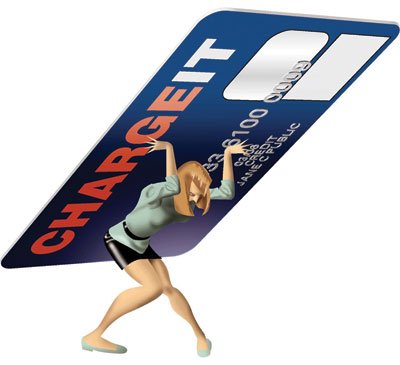You’ve sealed your commitment with a kiss and a kick-butt party.
And now the Visa bill is due
– yikes.
You’ve sealed your commitment with a kiss and a kick-butt party. And now the Visa bill is due – yikes.
But debt doesn’t have to kill the mood. But if you’re like the average American, you carry about eight credit and charge cards in your wallet, owe more than $7,500 and are paying around 14 percent in interest on those balances. If you paid off your credit card balance in full last month, take a bow – you’re part of the 40-percent minority who did so.
If you’re struggling with debt, clearly you are not alone. Being debt-free takes resolve and a little know-how.
Separate ‘Bad debt’
and ‘ok debt’
Unless your last name is Hilton, some debt is inescapable. How do you tell the difference? OK debt has an interest rate well under 10 percent – preferably with some tax advantages to boot. In the best case, the thing you bought with borrowed funds will appreciate in value. (Think mortgage, and even that student loan.) Bad debt is everything else – from your titanium credit card to the 35-percent loan from Angoraland.
Don’t Pay by Their Rules
You’re smarter than they are – and by “they,” we mean the suits on the receiving end of your hard-earned paycheck. You know that the “minimum amount due” is cleverly calculated to keep you beholden to The Man for your entire adult life. A $4,500 balance on a card with an 11-percent APR will take 44 years to pay off, even if you don’ t put another dime on the card. Oh, and the interest you’ll pay on that loan? A cool $17 grand. That’s why you’re going to pay by your rules. Keep reading.
Get Intimate with Your Visa
Gather your bills and clear a space at the kitchen table to line them up. Find the minimum monthly payment for each account, add them up, and behold your overall monthly minimum.
But you, you go-getter, have a plan. Rank your cards from lowest to highest interest rate. Identify the one major credit card with the lowest annual interest rate and room for a balance transfer. Your other cards are now dead to you – take them out of commission. Cut them up, if you have to, or throw them behind a major appliance. Promise that you’ll use the one card left intact for emergencies only.
Shop Around
for a Better Deal
If you or your honey have got a decent credit report card, you may qualify for “teaser rates” – low, short-term interest rates – from your credit card’s competition. Move as much of your higher interest debt onto those cards as possible and then put the card under lock and key. If it is going to take you a while to pay off your balances, it’s worth it to find the lowest rate you can get for the longest period of time. But do this as few times as possible: The less you have to apply for new credit, open the new account, transfer a balance and close the old account; the more simple your finances (and your credit record) will be.
Lather, Rinse, Repeat
Repetition is the key to success. Pay the minimum amount due (on time, every time!) on all accounts except the one with the highest rate. Send every extra dollar, every quarter you find on the street, every dime you earn over time and that $20 your mother-in-law gave you for cab fare last month to the high-interest rate winner – well beyond the minimum your lender hopes you’ll pay from now until eternity. Lather, rinse, and repeat until you’ve washed each debt right out of your hair.
Be Prudent
Be aggressive in paying down your debts, but don’t get so ambitious that you risk missing minimum payments on your mortgage, automobile or any other secured credit account. (Secured means that if you miss enough payments, the bank can show up and take your stuff.) A small emergency stash of cash will help cover those budget busters. Sticking to this plan requires willpower over a long period of time. Anticipate strong shopping cravings that will arise during your debt triage, and give each other props for each day you keep your cards in your wallet. Mark some reward days on your calendar to celebrate (inexpensively) your newfound savings mantra.
Resolve to Spend Less Than You Make
If you can’t pay for it today then you can’t afford it. In a household built for two, that goes doubly. Sound harsh? At least the math’s easy. Getting and staying out of debt boils down to this simple formula: Outflow is less than inflow. In other words, spend less money than you make, on a consistent, long-term basis. By making just a few small sacrifices – and paying a little more attention to the bigger money items – you can amass a nice chunk of change in just a few months. Look at you! Not only out of debt, but saving for the future!














